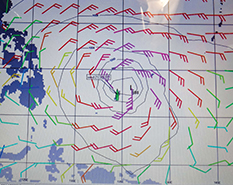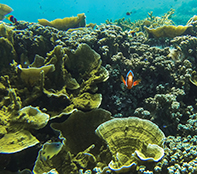Discovering paradise, cheeseburgers and a little slice of America (published June 2015)
I didn’t get the full meaning of Jimmy Buffet’s song Cheeseburger in Paradise until we started sailing to faraway tropical islands. There, delicious papayas, pineapples, mangos and bananas can be had for a bag of sugar, flour or rice. Fish is abundant and lobster plentiful. But on a small sailboat with no freezer, cheeseburgers just don’t happen. When we finally make it to a developed country we don’t even glance at seafood. We head straight for a spot that will plop down a big warm bun and a huge hunk of meat.
So, it was with great pleasure that we were tied on the closest mooring to Sam’s Tours and Dive Center and the Royal Belau Yacht Club in Koror, Palau where Agustin makes juicy bacon cheeseburgers. Jim and I were elated, thankful and embarrassingly gluttonous.
HOSPITALITY & NATURAL BEAUTY

Palau is a gorgeous archipelago with 26 large islands and more than 300 tiny, domed, forested islets. It is the farthest west of the Caroline Islands in the Federated States of Micronesia, a few days’ sail east of the Philippines and 950 miles north of Jayapura, Indonesia.

Palau is a paradise for American cruisers. We are issued a visa on arrival for one year and are allowed to stay indefinitely. A mooring in front of Sam’s Tours costs $50 per month. There are hot showers, trash disposal, a dive shop, restaurant, bar and fuel dock. They accept mail and Sam and his crew take great care of their customers. They’ll even pick up cruisers who book dives from their boats anchored in the Rock Islands.

That alone would entice us to stay if we felt the need to linger somewhere, but there are other benefits as well. The area is absolutely stunning! Beneath the water’s surface is pure delight with healthy, vibrant hard and soft corals and plenty of fish. The color of the water varies from pale aquamarine to deep cobalt. It’s too warm to be invigorating, but just right to spend hours immersed observing reef life. Occasional crocodile and banded sea snake sightings add a little excitement.
TYPHOON HAIYAN

Jim and I had been in Palau two and a half weeks when something interesting showed up on the GRIB files. “Oh that blip,” Laura on s/v Zen said when we told her we were heading out to a safe anchorage because of what we’d seen on the weather charts. She had been in Palau for two years and endured Typhoon Bopha the previous December. For a split second we questioned our decision. Later in the day Brynn at Commander’s Weather sent a heads up message suggesting we find a safe spot and Tom on s/v Toucan warned us, “That second storm forming looks a lot like Bopha.”
Just south of Koror are the Rock Islands, a large and lovely cruising area. Made of limestone and undercut by the tide, leafy foliage hangs over clear water and makes the islands look like green mushrooms floating on shimmering slabs of turquoise. It is a spectacular place to kayak, snorkel and tie a boat when a typhoon threatens.

Nine miles and almost two hours of slow motoring from Sam’s brings us to a stunning, secluded, safe spot in the Rock Islands. We know it only as anchorage A202 from The Palau Guide book. No other boats are here and there are no houses, roads or tracks ashore. We drop the anchor and I tie three lines to shore. The anchor is well set because Jim puts Tenaya into hard reverse several times to give me enough slack to get a line around the windward tree. Our bow is pointing to the southwest where the strongest of the winds will come from. We are near the tip of a crooked finger, but far enough out to catch a breeze.
Concerned that swell and wind will come from the northwest where the hills are low and farther away, Jim takes the Fortress anchor out in the dinghy while I feed out the rode. Once it settles I crank in the slack. We hope it holds when the wind kicks up the following night.

With all the steep islands around it is difficult to hold onto a satellite long enough to download new GRIB files. These are the charts that show wind speeds and direction. Barbs are shaped like arrows with the front pointing the direction the wind is blowing and the feathers showing the speed. One full line is 10 knots. One-half line is 5 knots. Add them together to get the wind speed. Our boat is the green thing near the middle of the circle. The flag on the purple barb nearest to Tenaya means 50 knots, so that particular barb shows that 75 knots will be coming over us shortly.
At about 5:00 p.m. the wind starts to blow from the north. Around 7:00 p.m. it whistles and starts to rain. By 9:00 p.m. it is pouring and howling, heeling us to port. Jim checks the wind speed. It’s in the high 30s. How high will it go? There is nothing more we can do. We’re scared. We huddle together on our bed and I make deals with God.

As the night crawls on, the wind screams through the trees. Jim is forced under the locker that hangs above his side of the bed and I stick to his other side. At some point we realize the anchors will hold and we will not smash into the rock wall near the stern. We doze. The wind moves around to the east, southeast, south and then southwest. The boat stops heeling. We sleep.
We awake with the sun shining through the hatch above our heads. It is plastered with leaves. We unfold our bodies and realize the ordeal is over. Haiyan passed in 12 hours instead of 24. It picked up speed and turned north just as it reached Palau so those of us near Koror missed a direct hit. The typhoon was still forming and would grow to monstrous proportions before it smashed into the Philippines.
Happy for surviving unscathed we go back to our mooring to check in with friends, get an Internet fix, and celebrate with a cheeseburger and cold draft beer. We learned all the boats were safe and the island sustained some damage but nothing extensive.
TASTE OF AMERICA
Palau enjoys Free Association with the United States. The U.S. military has access to the large natural harbors while Palauans benefit from all kinds of goodies from the States. After three months in Papua New Guinea I was thrilled to find many familiar treats. The first time my new friend, Joan, took me to an air-conditioned supermarket I scooped up a bag of Reese’s and a bundle of apples. Jim and I were thrilled wandering through the enormous ACE Hardware store stocked to the ceiling. Concentrated Simple Green, rolls of Velcro, thick paper towels and natural sponges—so many things I searched out in New Zealand and Australia but could not find. Palau is just another zip code in the U.S. Postal Service system so anything not available here can be easily ordered and inexpensively shipped.
ROCK ISLANDS

The Palau Guide identifies about 80 anchorages in the Rock Islands. Many have shallow bars at the entrance and require half to full tide to clear, but when we go out again we choose those that are accessible anytime. It is a scenic journey and we are mindful of the many reefs scattered about inside the lagoon. Our Navionics chart is off and it is disconcerting to be moving over a picture of a reef even though our eyes, depth sounder and waypoints assure us we are safe.
For those of us passing through, special permits must be acquired before anchoring here. A Rock Island Yacht Permit is $20 per month and the Rock Island Use Permit is $50 per person, good for 10 consecutive days. That is steep but worth the price for safe, secluded, spectacular anchorages with splendid snorkeling, sensational kayaking, and some of the best diving in the world. Another $50 each allows entry to Jellyfish Lake.

Saltwater seeps through fissures in the limestone terrain to create Jellyfish Lake. The water is murky green like pea soup. At first we see only a few lone glutinous globs but soon we are surrounded—big ones, small ones, pulsating in and out, moving up and down, left and right. It is impossible not to brush up against them. We do not duck dive deep because the bottom is toxic. Scuba diving is not allowed.
The longer I stay, the more my feelings about the jellyfish change. Instead of thinking them creepy, I begin to see their beauty and vulnerability. I want to protect them from the flailing fins of folks floating on boogie boards and wearing lifejackets.

The Rock Islands are a beautiful place to kayak. There are overhangs to paddle beneath at low water, caves to peer into, coral to gaze down upon and turtles to watch gliding by while tropicbirds, terns, noddies and bats soar overhead. A lovely mile and a half paddle from anchorage A420 brings us to Cemetery Reef, a popular snorkeling spot. The place is lined with tour boats in the morning and afternoon but they break for lunch so that’s when Jim and I go and have the reef to ourselves.

As soon as we slide into the water, hordes of scissortail sergeants and blue and yellow fusiliers surround us. The tour guides must feed them. We see yellow-masked angelfish, ternate and staghorn damsels, coral rabbitfish, red and black anemonefish, titan triggerfish, lined butterflyfish, striped and blue lined surgeonfish, moorish idols, pearly monacle bream, unicornfish, redbreasted and crescent wrasses, a few Napoleon wrasses and many more we can’t photograph to identify. The reef is healthy and dense with colorful coral; in the entire area we only see one Crown of Thorns sea star.

Across the narrow channel is anchorage A215 and we paddle in to have a look. The entrance has two meters at low water. Whoa, we would be nervous bringing Tenaya in over all that coral. Inside is a big, protected hole that would be an ideal typhoon shelter. We find plate coral, fleshy coral, soft coral trees and tunicates while snorkeling along the north wall.
Palau is a pristine dive location; one of the world’s best. We dive Siaes Corner which is a breathtaking wall with oodles of creatures. Two turtles, several reef sharks, a large Napoleon wrasse, an enormous colorful triggerfish and a moray eel are some of the highlights. We also dive Ulong Channel where we hook onto the reef and watch black-tip reef sharks swim by before releasing ourselves to slowly drift into the lagoon over coral, sponges and a plethora of fish.

Back at Sam’s is one more highlight. As the sun sinks low in the sky, mandarin dragonets can be spotted on the wall that descends from the restaurant. What a treat to have one of these elusive beauties emerge from hiding with its long dorsal fin billowing brilliant blue and orange like a flowing silk gown. We would love to stay in Palau longer but need to keep moving west. After one last cheeseburger we drop our mooring and head off to the Philippines.
Jim and Katie Thomsen received the Ocean Cruising Club’s Rambler Medal for 2012 in recognition both of their cruising among the islands of Vanuatu and their positive actions once ashore. As they sail west, they continue to delve deeply into the waters and cultures they visit. Katie chronicles their adventures at www.tenayatravels.com.

















